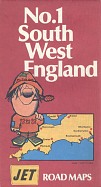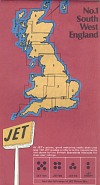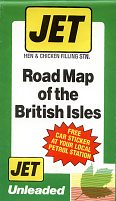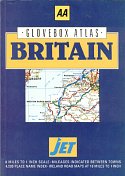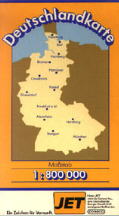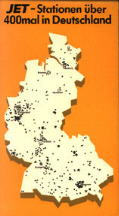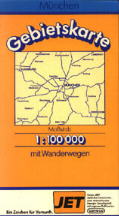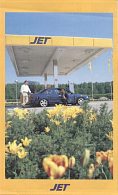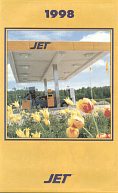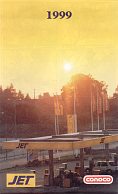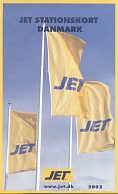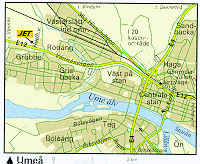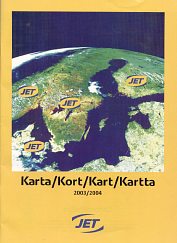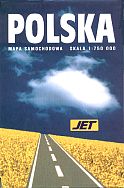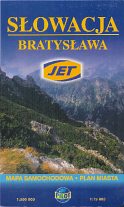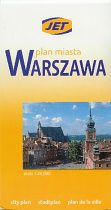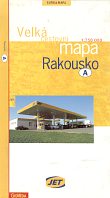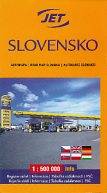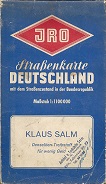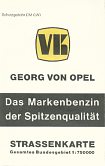JET
Conoco, Klaus Salm, Sopi, VK
Brief History
Jet Petroleum was formed in Yorkshire, England in 1953 (taking its name from local vehicle registration plates). Soon finding a niche in price cutting, Jet's 250 stations were acquired by the American company Conoco in Spring 1961. This was its first downstream operation in Europe since selling its interest in Sealand Petroleum (which used the Dominion brand) in 1933, seven years after it had been bought by Conoco's predecessor, Marland.
Conoco's next major purchase was Sopi, which supplied nearly 500 service stations in Germany and Austria. Further acquisitions in the 1960s included Marathon's small chain in Northern Italy, filling stations in Ireland and the SECA branded chain of the Société Européenne Des Carburants in Belgium & Luxembourg as Conoco needed to find outlets for its plentiful Libyan oil. |
Conoco tested a specifically European "big C" logo (which is not known on any maps) in several countries, but it did not prove successful and by the early 70s was replaced by Jet.
The oldest known Jet "map" is this guide contained a sliding card marked with red blobs aligned beneath holes on a basic map of Central London. Sliding the card revealed addresses and opening hours of places of interest on the side shown and car parks on the reverse. |
In 2002 Conoco merged with its domestic rival Phillips 66, which had only had very limited operations in Europe. (Phillips owned a 50% share of a British oil refinery, distributed diesel under its own name and at one time supplied jobbers using the TOPS brand, but had sold its remaining UK interests to the Dutch firm Petroplus in 2001.) In 2004 ConocoPhillips acquired a minority stake in the Russian Lukoil. As Russia was a major exporter of oil to Europe, it made sense to sell some of the retailing assets to Lukoil, and in early 2007 it was agreed to divest the Jet assets in Belgium, Finland, Poland, Slovakia and the Czech Republic. Jet's Scandinavia chain was sold in 2009, with Norwegian (and some Swedish) sites going to the Finnish company St1 and most of the Danish and Swedish ones passing to Statoil, who replaced the Jet name with Ingo on around 200 locations. With the splitting of ConocoPhillips into upstream and downstream operations in 2012, the remaining Jet operations in the UK, Germany and Austria passed to Phillips 66, although the Jet brand remains in use.
Maps: Jet
As a discounter with relatively small numbers of full service stations, Jet has only been an intermittent issuer of maps.
|
|
|
|
|
|
Jet's first UK map was a series of 68 small format route cards, covering all of the country at 10 miles to the inch. Produced by Map Productions Ltd, the set came in a yellow vinyl wallet with a 24 page gazetteer. Four cards of major cities and a clear plastic holder completed this 1970 set. In the following year, Jet issued its only British sheet maps in a series of nine, each illustrated with a humorous character on the cover. The rear cover showed how Jet's four grades fitted into the new BS star ratings. All were drawn by George Philip at 4 miles to the inch.
After a long pause, Jet issued a free map to promote the location of its stations selling unleaded petrol. This dated from 1988/9, and included a coupon for £5 off at Halfords to have your car converted to run on unleaded fuel, as well as an entry coupon for a Halfords competition. The example shown was stamped by Hen & Chicken Filling Station in Hampshire, a location that once sold Conoco fuel as well as Jet.
AA produced a version of their 96 page small format Glovebox atlas for use with a Jet oils promotion in 1992. This is the only map with the revised British logo on it. Across the Irish Sea, Jet issued a Handy Map of Ireland in 1986, (not shown here).
Jet Unleaded map image courtesy Richard Horwitz
|
|
|
|
Jet issued a number of maps in West Germany in 1979. Each had card covers and measured around 9.5 by 5.25 inches; cartography was by Haupka & Co. Shown (L-R) are the map of Germany at 1:800,000; the common rear cover design marking Jet locations with red dots; and the map of the Munich area at the enlarged scale of 1:100,000. |
|
|
|
|
|
|
In recent years, Jet has issued a single sheet covering the whole of Scandinavia indicating Jet locations. Shown above (L-R) are the 1996, 1998 and 1999 covers; other years have the same general design as these but feature different service stations. The 1999 map gives the Conoco logo equal prominence to the Jet sign; the earlier maps lacked any form of Conoco logo. The most interesting feature of these maps is that they have a small plan for every city with a Jet location: by the 1999 edition there are a total of 165 such plans! The map of the Swedish city of Umeå is shown here. |
|
|
|
As station numbers grew in Denmark, it became clear that a larger scale map of that country was desirable, so from around 2001 onwards, a similar map was produced showing just that country (top right). Note how the Conoco logo has been dropped again. |
|
In 2002, at the time of the switch between the Seca and Jet brands in Belgium, a very small format map was printed, folding down to around 10cm x 8cm (although when unfolded it measured 71cm x 30cm). This map at 1:400,000 scale was produced in two versions - French and Flemish (shown here). |
|
|
|
|
|
|
|
Jet has grown rapidly in the former Eastern bloc countries, where there was no tradition of discounting petrol prices. The first three maps above come from its Polish subsidiary. The left-most dates from 1998; in the same year it also published a spiral bound atlas with a similar cover design. In recent years it has had a moderately extensive map programme extending to cover neighbouring countries (Slovakia, 2004) and major cities (Warsaw, 2006) as well as spiral bound atlases and of sheet maps Poland and Europe. All known Polish Jet maps have been produced by Daunpol.
The map programme that covers both the Czech Republic and Slovakia is possibly even larger, with a broader range of atlases in different formats and scales, as well as numerous sheets maps. The two example above are from 1998 (of Austria, with cartography by Kartografie Praha) and 2004 (of Slovakia, with cartography by its current partner Shocart).
German predecessor brands
Klaus Salm operated a chain of filling stations and hotels based in Köln (Cologne). At the time that this map was issued it had 11 filling stations, including eight in the city itself, and four hotels, all of which are listed on the rear cover. The undated map was printed around 1960 based on the road network, and was a stock JRO issue at 1:1,100,000 using a generic cover design overprinted for the company (more examples of this design are shown on the German independents pages). Klaus Salm had 48 filling stations when it sold its chain to Jet/Conoco in 1971.
Maps: VK Georg von Opel
The Volks-Kraftstoff ("People's Fuel") company was established in 1955 by Georg von Opel (a grandson of Adam Opel, founder of the car manufacturer) and had developed a chain of over 100 filling stations by the end of the decade. West Germany's first deep discounter, its image was dented when it was publicly revealed that its supplies were being bought from the Leuna refinery in East Germany. By 1969, when this JRO map of Germany was printed, it was using a simplified VK brand and giving more prominence to the "respectable" Opel family name. The map is at the relatively generous scale of 1:750,000, and lists all VK locations on its rear and inside cover - showing them to be spread fairly evenly across West Germany, excluding Berlin. However the map itself is overprinted with V-symbols locating Vergölst-Service-Stellen (tyre and automotive centres). In 1970, VK's 183 service stations were sold to Conoco and soon switched to the equally black and gold Jet brand. (Vergölst is now owned by Continental Tires and continues to operate over 250 autocentres nationwide.)
Text and layout © Ian Byrne, 1999-2017
All original copyrights in logos and map extracts and images are acknowledged and images are included on this site for identification purposes only.




